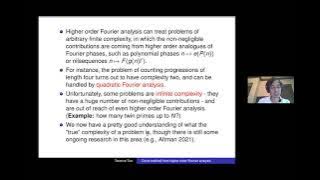Affine geometry | Triangle geometry | Linear algebra
Trilinear coordinates
In geometry, the trilinear coordinates x:y:z of a point relative to a given triangle describe the relative directed distances from the three sidelines of the triangle. Trilinear coordinates are an example of homogeneous coordinates. The ratio x:y is the ratio of the perpendicular distances from the point to the sides (extended if necessary) opposite vertices A and B respectively; the ratio y:z is the ratio of the perpendicular distances from the point to the sidelines opposite vertices B and C respectively; and likewise for z:x and vertices C and A. In the diagram at right, the trilinear coordinates of the indicated interior point are the actual distances (a', b', c'), or equivalently in ratio form, ka' : kb' : kc' for any positive constant k. If a point is on a sideline of the reference triangle, its corresponding trilinear coordinate is 0. If an exterior point is on the opposite side of a sideline from the interior of the triangle, its trilinear coordinate associated with that sideline is negative. It is impossible for all three trilinear coordinates to be non-positive. (Wikipedia).



















